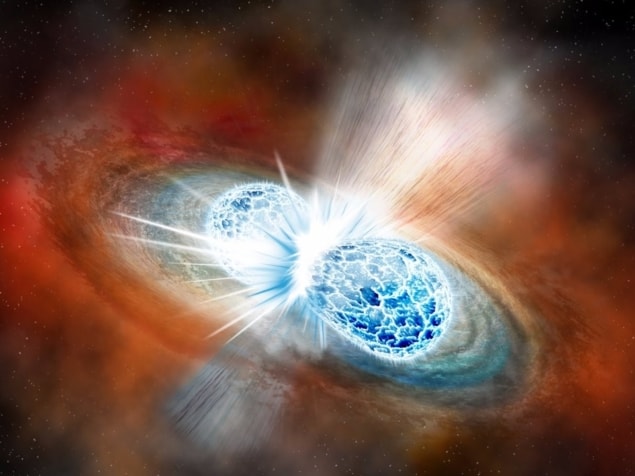
Multimessenger observations of neutron stars have been used by astrophysicists in the US to put Einstein’s general theory of relativity to the test – and the 106 year old theory has passed with flying colours.
A neutron star is the dense, core remnant of a massive star that has exploded as a supernova. Containing more mass than the Sun but only spanning 10–12 km in radius, neutron stars are incredibly dense and generate huge gravitational fields. These extreme conditions provide a laboratory for testing both the Standard Model of particle physics and general relativity.
A prime goal of neutron-star research is to determine the equation of state, which is the relationship between a star’s mass and its radius. It depends upon the nature of the matter inside a neutron star (be it neutrons, a quark–gluon plasma, or a more exotic type of particle such as hyperons) as well as the star’s energy density and internal pressure.
“A neutron star’s mass and radius are highly sensitive to both the equation of state and the gravitational theory used to model the star,” says Hector Silva of the Max Planck Institute for Gravitational Physics in Potsdam, who adds that this interrelatedness has been a “stumbling block” in efforts to test gravity using just the bulk properties of neutron stars.
Lovely relations
A breakthrough came 2013 when Nicolás Yunes of the University of Illinois at Urbana-Champaign, and Kent Yagi of the University of Virginia, discovered the “I-Love-Q” relations. The relations vary depending on which model of gravity you subscribe to, but in general they show how three of a neutron star’s bulk properties relate to one another. One property is the neutron star’s moment of inertia and another is its Love tidal number. The latter describes the rigidity of a neutron star, and therefore how easily it deforms in the gravitational field of a companion object – which is an important factor in binary-neutron-star mergers. The third property is the quadrupole moment, which defines how the star’s mass is distributed across its oblate shape.
Now Silva and Yunes, along with A Miguel Holgado of Carnegie Mellon University in Pennsylvania and Alejandro Cárdenas-Avendaño of the University of Illinois at Urbana-Champaign, have applied their model to real neutron stars with a little help from the Neutron Star Interior Composition Explorer (NICER) experiment on board the International Space Station, and the LIGO/Virgo gravitational-wave detectors.
In 2019 NICER directly measured the mass and radius of the isolated neutron star PSR J0030+0451, irrespective of the equation of state. Now, Silva, Yunes, Holgado and Cárdenas-Avendaño used these measurements to calculate the star’s moment of inertia, and then used the I-Love-Q relation to derive the Love number and quadrupole moment. Meanwhile, gravitational-wave measurements of the neutron-star merger GW 170817 provided an independent measure of the Love number for a neutron star with similar mass to PSR J0030+0451. Knowing these two values permitted a test of general relativity.
“The test is to check whether the inferred value of the Love number from the ‘I-Love’ relation is the same as the one measured with LIGO,” Yunes tells Physics World. “If it is, you’ve passed the test. If it isn’t, then it’s a sign of deviation from general relativity.”
Gravity’s mirror image
One application of the test is to constrain a property known as gravitational parity, explains Yunes. In physics, parity refers to mirror symmetry: the idea that something behaves the same way when reflected in a mirror. For example, when particles such as kaons decay, we would expect the same amount of decay products as their mirror image, but this doesn’t occur when parity is violated in the Standard Model.
In general relativity, gravitational parity should be preserved. However, if a modified form of gravity were at work inside a neutron star it would not necessarily preserve parity. This deviation from general relativity would be detectable in the polarization of gravitational waves measured by LIGO/Virgo, or in the frequency of gravitational waves emitted by binary black holes.

Distorted neutron stars give up secrets of dense nuclear matter
In this case, general relativity successfully passed the test. “Our result means that parity is preserved in gravity at the scale of neutron stars,” says Yunes. The next step, he says, would be to test for gravitational parity in an even more extreme environment, such as that of the inspiral and merger of black holes.
The team’s findings would not be possible without the onset of the new era of multimessenger astronomy – our ability to study astronomical objects not just in electromagnetic waves, but also in gravitational waves.
“It is quite nice that one has to combine neutron star observations in electromagnetic radiation and gravitational waves to perform this test,” says Silva. “This possibility was out of reach before 2019 and highlights the importance of using multimessenger observations to learn more about physics.”
The research is described in Physical Review Letters.



